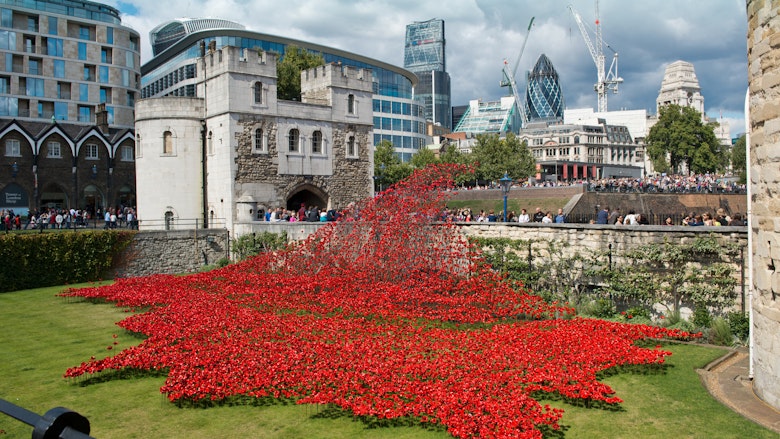Who is remembering for whom? Changing practice on remembrance at Historic Royal Palaces
Since 2012, Cardiff University’s Dr Jenny Kidd has worked with cultural institutions as they diversify remembrance activities and meaningfully engage non-traditional and younger audiences.
Whose remembrance is it anyway?
Museums and heritage sites are at the centre of negotiating complex public debates around the legacies of conflict and commemoration.
Their responsibility to represent commemorative events critically, along with the need to engage more diverse public audiences, creates ethical challenges and a need to better engage with the political, societal, and cultural legacies of conflict.
Building knowledge through research
With colleagues in the cultural sector, Dr Kidd co-founded the ‘Challenging History’ network which helped to explore how remembrance of sensitive and traumatic historical events might be handled in practice.
Alongside this, Dr Kidd was Co-Investigator on two UK-wide research networks funded by the Arts and Humanities Research Council (AHRC). The ‘Silence, Memory and Empathy’ network explored how silence, empathy and memory interact in museum settings and at historic sites. The ‘Significance of the Centenary’ network, hosted by Historic Royal Palaces (HRP), reflected on anniversary cultures, why we remember, and the significance of marking a centenary.
Through these activities, Dr Kidd and colleagues identified a range of sensitivities around commemoration activities, and a resultant tendency toward risk-aversion in practice at that time.
Dr Kidd later worked jointly with Dr Joanne Sayner at Newcastle University to lead the commemoration strand of the Voices of War and Peace WW1 Engagement Centre, which catalysed a range of innovative and collaborative engagement initiatives around the centenary.

Changing Historic Royal Palaces’ approach to remembrance
The ‘Significance of the Centenary’ research also informed HRP’s Why Remember? learning programme, which sought to engage audiences in meaningful reflection as it commemorated the 2014 centenary of the outbreak of the First World War.
The programme asked visitors: why we should remember the war; why 100 years are significant; and how do you want to remember.
These questions helped visitors to develop a personalised approach to remembrance, regardless of their background.

The programme reached over 1.25 million people worldwide and included:
- activities for 2,500 children and young people including object-handling, storytelling, and costume interpretation
- a theatre performance and a family trail undertaken by over 10,000 people
- a programme on the Discovery Channel, which used the three questions to engage students and support teachers in the associated professional development programme, which reached 1 million students in 61 countries
Alex Drago, Explorer Manager at HRP at that time said: “Why Remember? was especially important for Historic Royal Palaces because it helped non-traditional and younger audiences engage with the centenary” and “promoted stronger and more connected communities… by developing an appreciation of the sacrifices of all those who lived during the First World War.”
Embedding a new approach
Why Remember? was so successful that its approach was used again by HRP for Beyond the Deepening Shadows, an installation of flames in the Tower moat to commemorate the centenary of the end of the First World War.
Research at HRP had previously focused on market research and quantitative data, but Dr Kidd’s work brought innovative ideas about content analysis, critical discourse analysis, research ethics and theoretical thinking.
Impact and legacy
This new approach to research contributed to HRP’s successful application for Independent Research Organisation status in 2015.
Its new status has allowed it to apply for research funding for the first time. It has since been awarded five grants as Principal Investigator, totaling over £407,000, on subjects including Tudor dwellings, Henry VIII’s palaces, and Queen Victoria’s royal image, allowing HRP to place research and critical thinking at the forefront of its approach to audience engagement.
Selected publications
- Kidd, J. 2019. Unprecedented times? Shifting press perceptions on museums and activism. In: Janes, R. R. and Sandell, R. eds. Museum Activism. Museum Meanings London and New York: Routledge. , pp.388-399.
- Kidd, J. and Sayner, J. 2019. Intersections of silence and empathy in heritage practice. International Journal of Heritage Studies 25 (1), pp.1-4. (10.1080/13527258.2018.1475414)
- Kidd, J. and Sayner, J. 2018. Unthinking remembrance? Blood Swept Lands and Seas of Red and the significance of centenaries. Cultural Trends 27 (2), pp.68-82. (10.1080/09548963.2018.1453448)
- Kidd, J. 2017. Debating contemporary museum ethics: reporting Sekhemka. International Journal of Heritage Studies 23 (6), pp.493-505.
